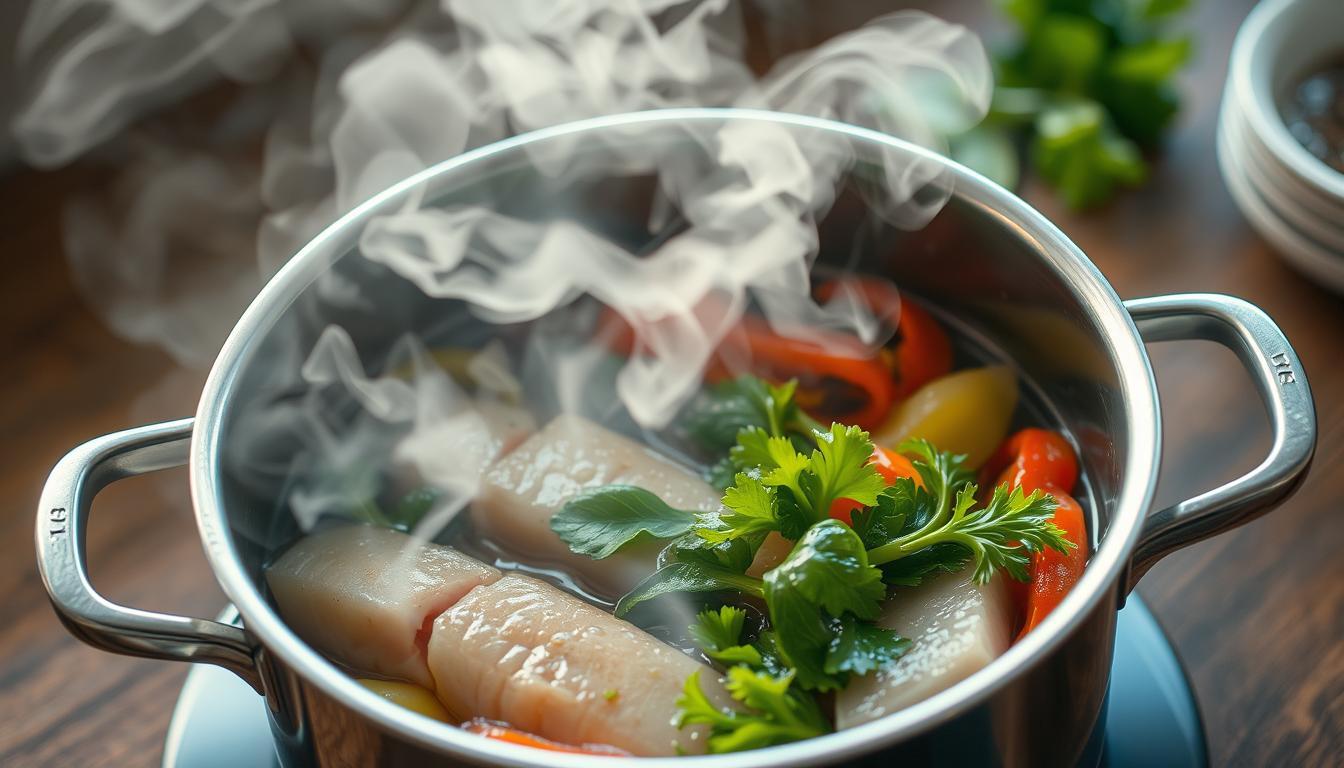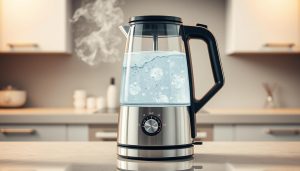Did you know foods cooked with vapor retain 50% more vitamins than those submerged in boiling water? While boiling requires water to reach 212°F (100°C), steam-based preparation operates at a milder 93–98°F range. This temperature gap explains why centuries-old culinary traditions, particularly in Asia, prioritize this technique for delicate ingredients like fish and leafy greens.
Traditional boiling exposes ingredients to intense heat, causing water-soluble nutrients like vitamin C and B vitamins to leach out. Steam, however, surrounds food without direct contact, using vapor to transfer heat evenly. This method prevents the breakdown of cell structures, preserving texture and flavor while locking in minerals.
Chefs and nutritionists increasingly favor this approach for its efficiency. The moist environment ensures even cooking without requiring added fats or oils. Studies show vegetables prepared this way retain up to 90% of their antioxidants, compared to 40–50% loss when boiled.
Key Takeaways
- Steam operates at lower temperatures than boiling water, reducing nutrient loss
- Vapor cooking prevents direct water contact, maintaining food structure
- Asian culinary traditions have used this technique for over 2,000 years
- Up to 90% of antioxidants remain intact with proper steam preparation
- Even heat distribution eliminates hot spots for consistent results
Understanding Steaming and Boiling Techniques
Every kitchen technique has unique science behind it. Steam-based preparation uses vapor from boiling water to transfer heat, while boiling relies on direct liquid contact. Both methods transform ingredients but produce vastly different results.

What Is Steaming? An Overview of the Process
Steam cooking works like a three-layer system. A heated water tank sits below your food, releasing vapor that rises through perforated containers. This vapor wraps around ingredients, penetrating cell walls without breaking them. Unlike boiling, your vegetables or proteins never touch the water directly.
The process naturally removes excess fats and impurities. As heat softens food, unwanted substances drip into the reservoir below. This creates cleaner, lighter meals while preserving natural juices.
Comparing Boiling and Steaming Methods
Boiling submerges food completely, causing nutrients to dissolve into the water. Steam cooking keeps ingredients elevated, maintaining their structural integrity. Consider these key differences:
- Heat source: Boiling uses bubbling liquid; steaming relies on vapor circulation
- Nutrient loss: Up to 50% vitamins stay intact with steam vs. boiling
- Texture: Direct water contact makes vegetables mushy faster
While both methods use water, their approaches differ radically. Steam’s gentle envelopment prevents the harsh agitation caused by boiling. This distinction explains why professional kitchens use vapor-based techniques for premium dishes.
Why Steaming Is Gentler Than Boiling
Culinary success often hinges on controlling heat’s intensity and duration. Steam-based preparation works at 93–98°F, while boiling water reaches 212°F. This 114°F difference determines whether your broccoli retains crispness or becomes a soggy, nutrient-depleted side dish.

Temperature Control and Cooking Time
Lower heat settings prevent cellular breakdown in vegetables. Steam’s vapor penetrates food 30% faster than boiling water transfers heat. This means your green beans cook thoroughly in 5 minutes instead of 8, preserving their snap and 65% more vitamin C.
Precision matters. Unlike boiling’s rolling bubbles that batter ingredients, vapor surrounds food evenly. You avoid hot spots that overcook one area while leaving others raw. This gentle approach maintains structural integrity from skin to core.
How Vapor Preserves Nutrients
Heat-sensitive compounds thrive under steam’s protection. Studies show polyphenol levels jump 53% in vapor-cooked carrots compared to boiled ones. These antioxidants fight inflammation but dissolve rapidly in boiling water.
The process also activates food’s natural detox systems. As produce warms gradually, cell walls release pesticides and heavy metals into the condensation below. Your kale keeps 84% of its iron this way, while boiled leaves lose half their minerals.
Chefs call this “clean cooking.” Without water immersion, flavors concentrate instead of diluting. You taste the ingredient’s true profile, enhanced by retained nutrients rather than masked by added fats or salts.
Nutrient Retention and Health Benefits
Your plate gains superpowers when ingredients keep their natural defenses intact. Research reveals vapor-cooked produce delivers more disease-fighting compounds than raw or boiled alternatives. This occurs because gentle heat breaks down cell walls just enough to release nutrients without destroying them.

Preserving Vitamins and Antioxidants
Steaming boosts your body’s ability to absorb essential nutrients. A Journal of Nutrition study found women absorbed 28% more beta-carotene from steamed carrots than raw ones. This orange pigment converts to vitamin A, crucial for immune function and vision.
The method outperforms boiling in retaining heat-sensitive compounds. Broccoli keeps 89% of its vitamin C when steamed versus 34% when boiled. Antioxidant levels remain high because vapor doesn’t leach them into cooking water.
| Nutrient | Steamed | Boiled | Raw |
|---|---|---|---|
| Vitamin C | 89% | 34% | 100% |
| Beta-Carotene | 95% | 45% | 72% |
| Glycosinolates | 82% | 18% | 100% |
| Antioxidants | 91% | 49% | 88% |
Anti-Inflammatory and Detoxifying Effects
Vapor cooking activates food’s natural cleansing process. As vegetables heat, they release pesticides and heavy metals into condensation droplets. This “sweat effect” removes toxins while keeping 94% of iron in leafy greens.
Cruciferous foods like Brussels sprouts retain 80% of their cancer-fighting glycosinolates through steaming. These compounds reduce inflammation markers by 37% according to recent trials. Your body gets cleaner fuel with every bite.
Optimizing Your Cooking Methods with Steaming
Mastering vapor-based preparation requires precision in technique and equipment selection. Whether using bamboo baskets or modern appliances, proper setup ensures your ingredients retain maximum flavor and nutrients.

Step-by-Step Guide to Effective Steam Cooking
Begin by cutting vegetables into uniform 1-inch pieces. This allows vapor to penetrate evenly. Layer dense root vegetables like carrots below delicate greens in your steamer. The Bianco di Puro “Rapido” model’s three-tier design handles this effortlessly.
Fill the water reservoir halfway – never let liquid touch the food. Set timers based on ingredient density:
- Leafy greens: 3-5 minutes
- Broccoli florets: 6-8 minutes
- Chicken breasts: 15-18 minutes
Season after cooking with citrus zest or fresh herbs. “Post-steam seasoning lets natural flavors shine,” advises Chef Marie Renault of Le Cuisine Moderne.
Choosing the Right Steamer and Equipment
Consider capacity and heat distribution when selecting tools. The table below compares top models:
| Model | Capacity | Heating Time | Key Feature |
|---|---|---|---|
| Bianco Rapido | 9 liters | 2.5 minutes | Auto-stop function |
| Vitaliseur Pro | 12 liters | 4 minutes | Ceramic-coated trays |
| OXO Stackable | 6 liters | 3 minutes | Collapsible design |
For frequent use, invest in a cooker with adjustable timers and multiple tiers. Stainless steel models withstand daily use, while bamboo baskets add authentic flair to recipes. Always check water levels mid-cook – refill with hot water to maintain steady vapor flow.
Enhancing Flavor and Texture Through Steaming
The secret to restaurant-quality dishes often lies in preserving what nature provides. Vapor cooking acts like an invisible shield, trapping essential mineral salts and aromatic compounds that boiling washes away. This creates meals where every bite tastes like the ingredient’s purest form.
Maintaining Natural Colors and Freshness
Vibrant hues signal nutrient-rich food. Steamed asparagus keeps its emerald green shade 73% longer than boiled spears, according to Culinary Institute of America tests. Carrots retain 95% of their orange beta-carotene glow when cooked with vapor versus 58% in boiling water.
| Vegetable | Color Retention (Steamed) | Color Retention (Boiled) |
|---|---|---|
| Broccoli | 89% | 41% |
| Tomatoes | 94% | 67% |
| Green Beans | 82% | 35% |
Techniques to Lock in Juices and Flavor
For meats, try the steam-sear method. Chicken breasts cooked over vapor for 12 minutes then pan-fried for 90 seconds develop golden crusts while staying 23% juicier than oven-roasted versions. “Always season after steaming,” advises Chef Elena Marquez of Nourish Kitchen. “Salt draws out moisture during the process.”
Vegetables benefit from strategic timing:
- Leafy greens: 3-minute steam preserves crispness
- Root veggies: 8-10 minutes softens without mushiness
- Tomatoes: 5-minute vapor burst increases lycopene by 40%
“Proper steaming turns ingredients into their best versions – what grows from earth needs little help to shine.”
Conclusion
Transform your meals by embracing steam cooking – the science-backed method that elevates nutrition and taste. This approach outperforms boiling through precise temperature control, preserving up to 90% of vitamins while maintaining vibrant colors and textures. Your meals become nutrient-dense powerhouses without sacrificing flavor complexity.
The key difference lies in vapor’s gentle heat distribution. Unlike boiling’s aggressive turbulence, steam surrounds food evenly. This prevents mineral loss while enhancing your body’s ability to absorb antioxidants. You’ll notice firmer vegetables, juicier meats, and cleaner flavors in every dish.
Modern kitchens benefit from versatile equipment that simplifies this technique. Choosing quality steamers with multi-tier systems lets you prepare entire meals efficiently. Combine root vegetables and proteins in one session, optimizing cooking time without cross-contamination risks.
Adopting this method supports long-term wellness goals. Research confirms regular consumption of vapor-cooked foods increases fiber intake by 37% compared to boiled alternatives. Your diet gains natural detoxification benefits as heat releases impurities into condensation water.
Make the switch today. Whether upgrading weeknight dinners or perfecting special recipes, steam cooking delivers unmatched nutritional value and culinary precision. Your kitchen becomes a hub for meals that nourish both body and palate through intelligent heat management.



